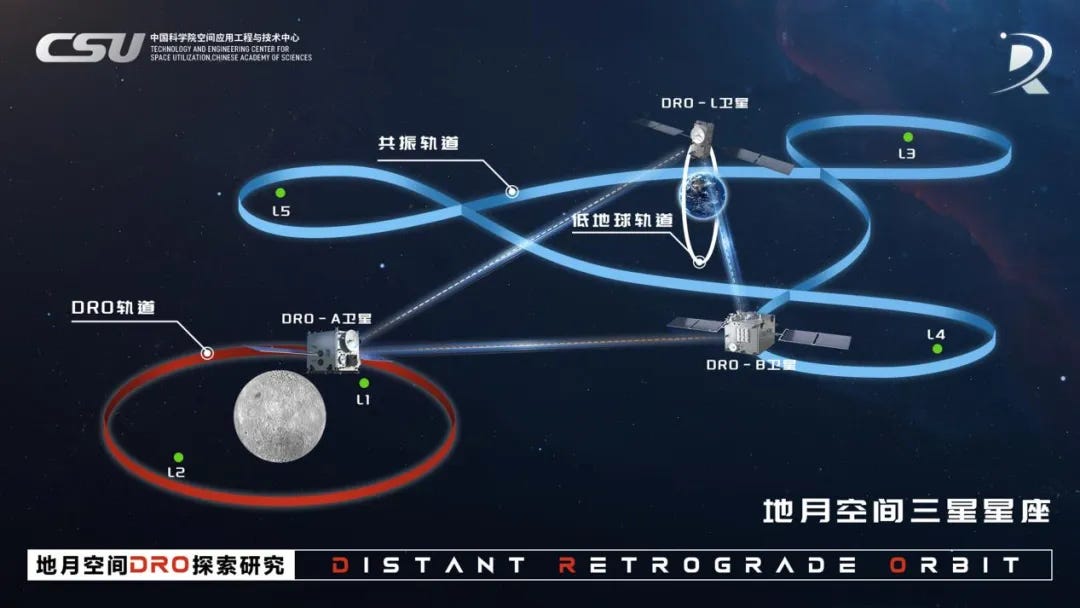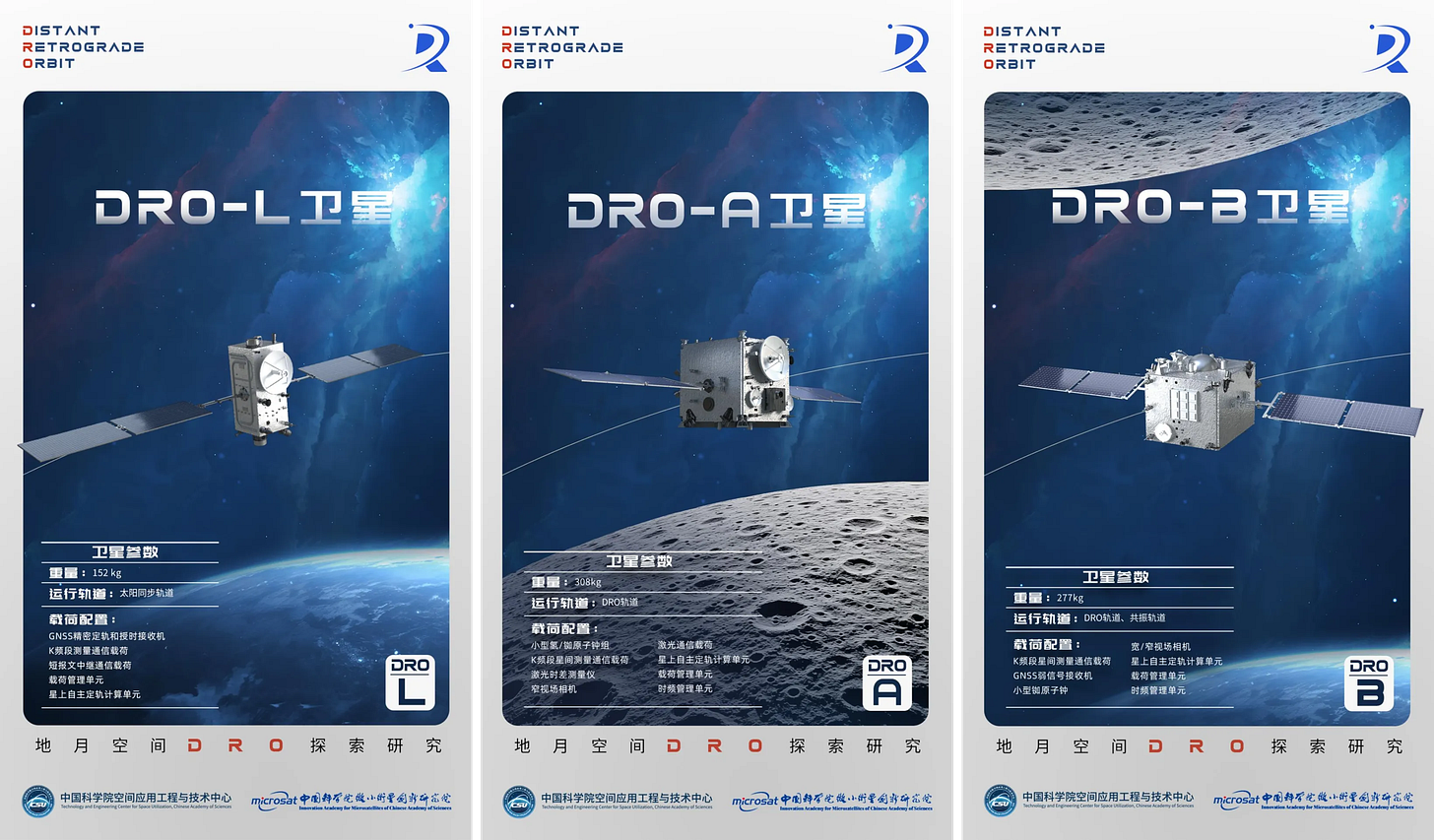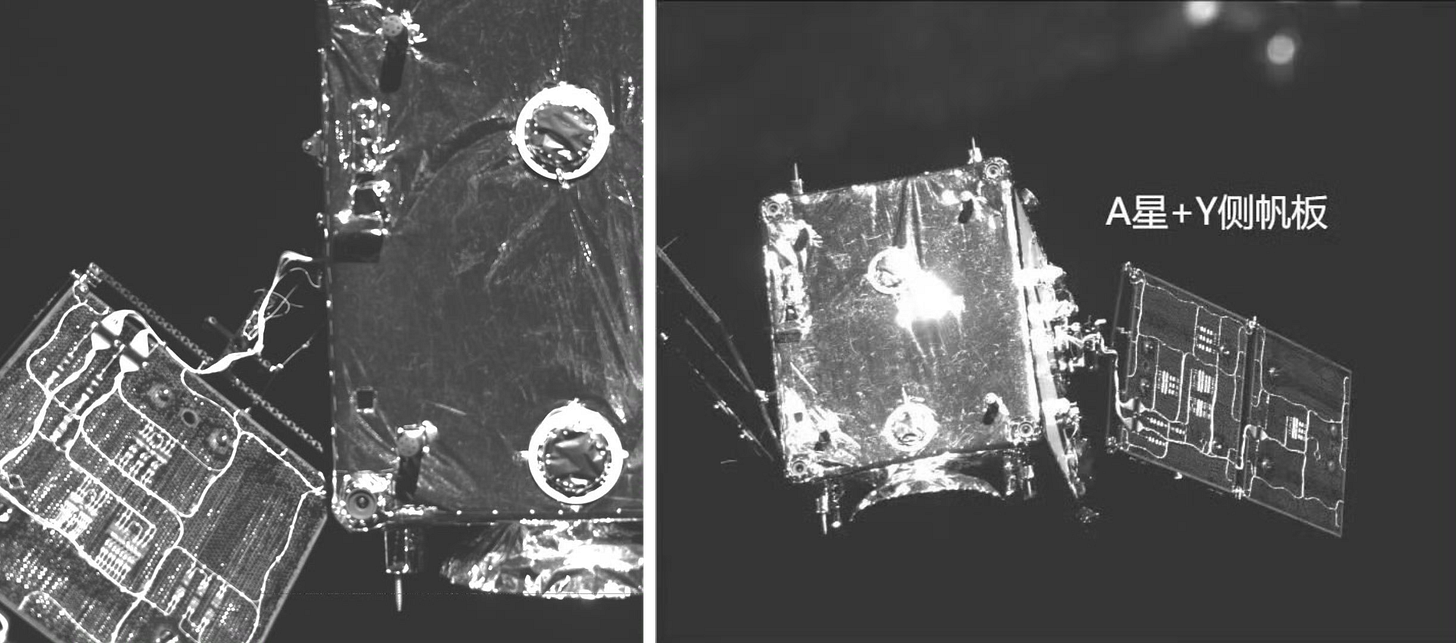China Begins Operating First Distant Retrograde Orbit Communications Network
The DRO network had an eventful journey to operation.

Today, April 16th, the Innovation Academy for Microsatellites, Chinese Academy of Sciences (中国科学院微小卫星创新研究院), also known as Shanghai Microsat, announced that its DRO Exploration network performed its first three satellite interlinks between Earth, lunar, and Distant Retrograde Orbits1 (DRO). Notably, becoming the first satellite network to do so, Shanghai Microsat claims.
Work on the three satellite network was performed by Shanghai Microsat and the Technology and Engineering Center for Space Utilization (中国科学院空间应用工程与技术中心). Xingyi Space (星邑空间) provided support by developing key software for the ground systems and testing.
For the network, three satellites were deployed across two launches. DRO-A and DRO-B, launched in March 2024, in lunar Distant Retrograde Orbit and an Earth-Moon resonance orbit respectively. The Earth orbit satellite in the network, DRO-L, was launched the month before, in February, atop of a Jielong-3 launch vehicle into a sun-synchronous orbit.
Speaking on the advantages of the network, Wang Wenbin (王文彬), researcher at the Chinese Academy of Sciences and Chief Architect of the program at the Technology and Engineering Center for Space Utilization, said:
"DRO's unique position allows spacecraft to enter Earth-Moon space with minimal energy expenditure while maintaining stable positioning and full-domain accessibility," — "This three-satellite system lays crucial infrastructure for maintaining continuous human activities in the Earth-Moon sphere," — "The constellation provides essential navigation, communication and logistical support — much like building harbors and supply depots along new maritime routes during the Age of Exploration."
During tests to interlink the satellites, the Chinese Academy of Sciences noted that K-band microwave measurement and communication links between the satellites and the ground were performed at a distance of 1.17 million kilometers. Additionally, the three satellites utilized three hours of in-orbit inter-satellite measurement data to determine their orbit at a precision level that would typically require two days of ground-based tracking.
Thanks to the spacecraft not operating in a low lunar orbit, each spacecraft has a line of sight to vast areas of the Moon’s surface for a longer period. Alongside this, it’s a cheaper orbit to access with Chief Engineer at Shanghai Microsat Zhang Jun (张军) adding:
"Our low-energy transfer strategy, exchanging extended flight time for fuel efficiency, enabled successful orbital insertion using just 20 percent of traditional fuel consumption"
DRO-A and DRO-B aren’t the first Chinese spacecraft to enter Distant Retrograde Orbit, with the Chang’e 5 orbiter operating in the orbit following its main mission, also becoming the world’s first spacecraft to enter it. NASA is also interested in Distant Retrograde Orbit, having flown the Artemis-1 mission to it as well as most crewed Orion spacecraft to it in the future.
Deputy Director of the Technology and Engineering Center for Space Utilization Wang Qiang (王蔷) expects breakthroughs made by the three DRO satellites to:
"Fundamentally transform our approach to cislunar infrastructure, dramatically lowering access barriers for sustained space exploration."
The Chinese Academy of Sciences expects China to deploy more satellites to Distant Retrograde Orbit around the Moon, among other complex orbital regimes, in the future. Likely part of the future Queqiao lunar communications network.
Saving DRO-A/B
Back in March 2024, a Long March 2C flew from the Xichang Satellite Launch Center with a Yuanzheng-1S upper-stage to carry the DRO-A and DRO-B satellites out toward the Moon. However, during the launch the upper-stage failed, leading to a many-month delay for DRO-A and DRO-B entering their intended orbit.
According to China Youth Daily (中青报), the Yuanzheng-1S suffered from an anomaly during its second burn, resulting in the satellite being placed in an orbit with an apogee2 of 134,00 kilometers, instead of the intended 292,000 kilometers. After separation, it was revealed that the DRO-A/B satellite combination was stuck in a spin, completing a rotation every 1.8 seconds. This spin was stopped shortly after following twenty minutes of thruster firings.
Once the spin was stopped, it was discovered that one of DRO-A’s solar panels was unable to lock into place following deployment while one of DRO-B’s was dislocated, but both were still generating power.
Following the recovery of the spacecraft from the dire post-launch state, teams performed calculations on the necessary burns and trajectory to carry out the mission. The result was another twenty-minute burn to raise DRO-A/B’s apogee to 240,000 kilometers for a trajectory that would use four Earth flybys and four Moon flybys.
The new trajectory was a success with DRO-A/B entering their designated orbits in July 2024. In late August the two spacecraft separated, also photographing each other.
Since publication, CGTN has also shared a story on recovering the satellites. I recommend reading it.
A Distant Retrograde Orbit is an orbit around a moon that is highly stable because of its interactions with two Lagrange points of the planet–moon system. (via Wikipedia on April 16th 2025)
Apogee is the highest point in an orbit around a celestial body, like the Earth or Moon.







